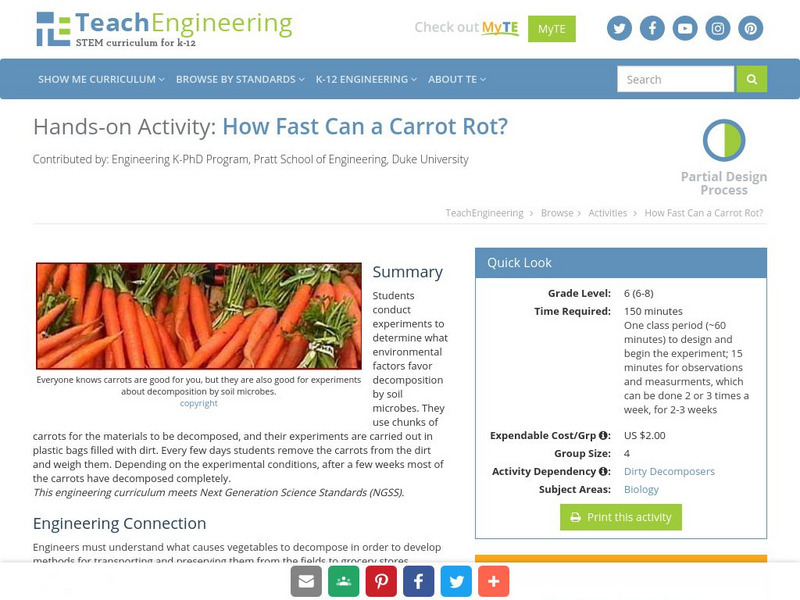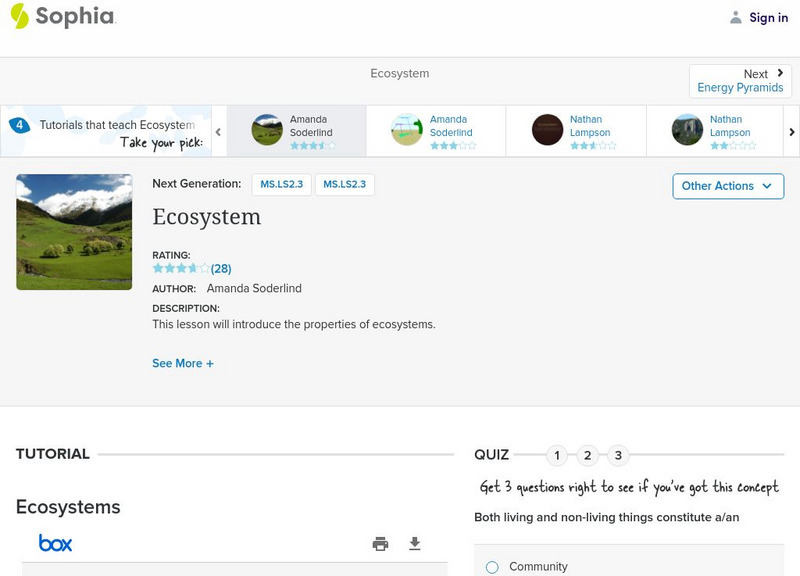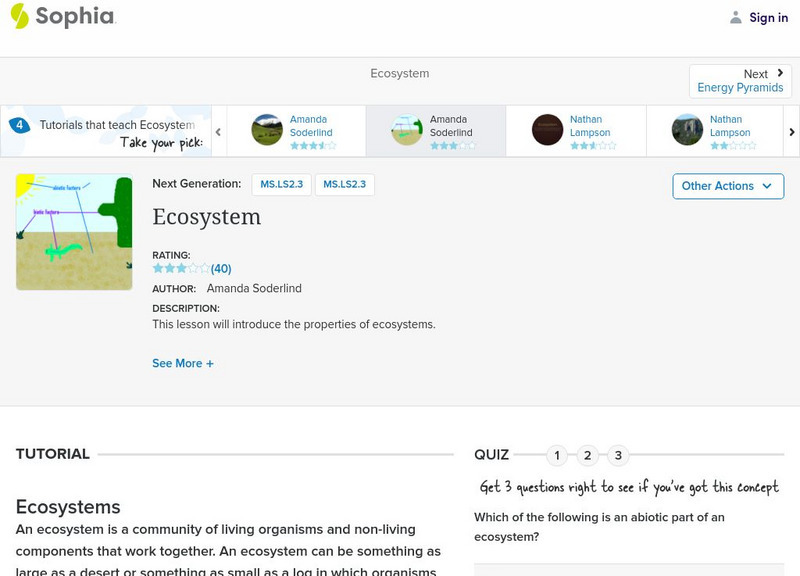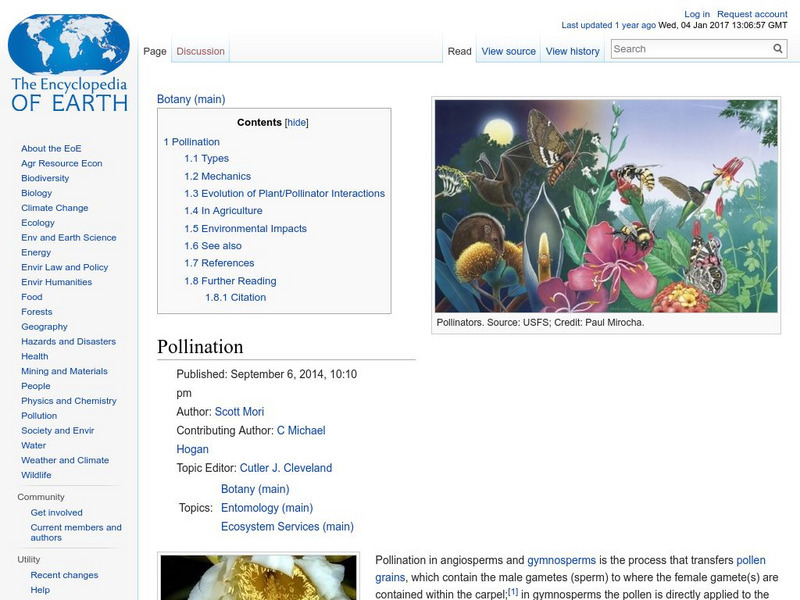Khan Academy
Khan Academy: What Is Ecology?
A webpage giving an overview of ecology. Learn about the biotic and abiotic factors that make up an ecosystem as well as the different levels of ecology.
TED Talks
Ted: Ted Ed: What Happens When Continents Collide?
Tens of millions of years ago, plate tectonics set North and South America on an unavoidable collision course that would change the face of the Earth and spell life or death for thousands of species. Juan D. Carrillo explains the massive...
Other
Hub Pages: Abiotic Factors: A Component of Ecosystem
In the environment, there are external factors that really affect organisms living within it. One of these factors is the set of abiotic factors, or nonliving variables, such as wind, ocean, day length, rainfall, temperature, and ocean...
Science Struck
Science Struck: Abiotic Factors of the Rainforest
Abiotic factors, e.g., sunlight and precipitation, play a huge role in supporting biodiversity in a rainforest. This article discusses the features of rainforests and how abiotic factors affect the plants and animals that live there.
Science Education Resource Center at Carleton College
Serc: Investigating the Long Meadow Lake Unit of Valley Nat'l Wildlife Refuge
This is a field investigation at the Bass Ponds Trailhead area in the MN Valley National Wildlife Refuge in which middle schoolers will collect data in the field and samples to test back in the classroom. Students will try to elicit the...
TeachEngineering
Teach Engineering: How Fast Can a Carrot Rot?
Students conduct experiments to determine what environmental factors favor decomposition by soil microbes. They use chunks of carrots for the materials to be decomposed, and their experiments are carried out in plastic bags filled with...
CK-12 Foundation
Ck 12: Characteristics of Life
[Free Registration/Login may be required to access all resource tools.] Videos, texts, activities, and assessments about the factors that characterize living things.
Texas Instruments
Texas Instruments: Ecology Vocabulary
This StudyCards stack enables students to review the vocabulary used in studying ecology.
Huntington Library
Huntington Library: Making Community Measurements: Abiotic Factors [Pdf]
A lesson plan in which students explore plant communities and observe different types of soil and weather conditions in an attempt to determine cause and effect relationships. Includes discussion questions, extension activities and web...
Sophia Learning
Sophia: Ecosystem
A PowerPoint giving a basic definition of an ecosystem. Also explained with a definition and examples are abiotic and biotic factors of the ecosystem.
PBS
Pbs Teachers: Canyonlands: Tonight Our Guest Is
This lesson will help students understand that animals adapt to abiotic and biotic conditions in their environment, some of which have evolved over a long period of time through the process of natural selection, and identify the...
BiologyWise
Biology Wise: Pollination of Flowers
Discusses what pollination is, the types, what happens during pollination, its importance in agriculture and horticulture, and the biotic and abiotic factors that facilitate pollination. Has some embedded ads.
BBC
Bbc: Gcse Bitesize: Adaptations, Interdependence and Competition Aqa
The abundance and distribution of organisms in an ecosystem is determined by biotic and abiotic factors. Animals and plants have adaptations to allow them to compete for resources.
University of Michigan
University of Michigan: The Concept of the Ecosystem
Lesson looks at the definition of an ecosystem, biogeochemical cycles, and factors responsible for the differences between ecosystems.
Oswego City School District
Regents Prep: Ecosystems/communities
Abiotic factors vary in the environment and determining the types and numbers of organisms that exist in that environment. Factors which determine the types and numbers of organisms of a species in an ecosystem are called limiting...
Climate Literacy
Clean: Global Patterns in Green Up and Green Down
Young scholars analyze and explore visualizations and graphs that show the annual cycle of plant growth and decline. They investigate several regions in each hemisphere that have different land cover and will match graphs that show...
PBS
Pbs Learning Media: River Rewilding: Advanced Water Quality
In this unit, students will try to improve stream quality and reduce human impacts by taking action.This Advanced Water Quality unit is packaged into three smaller parts: Part 1: Stream Habitat Assessment; Part 2: Macroinvertebrate...
Encyclopedia of Earth
Encyclopedia of Earth: Biogeochemistry: Phosphorus Cycle
Article explaining what the phosphorus cycle is, where it occurs, its place in the biotic world, and the environmental impact of human activities on the phosphorus cycle. (Published: October 8, 2009)
Sophia Learning
Sophia: Ecosystems
Gives basic information about the community that forms between living and non-living factors that function together in an ecosystem. [47 secs]
Georgia Department of Education
Ga Virtual Learning: Ap Biology: Ecology
Students review the study of living things and make connections back to Earth's systems. This unit focuses on how various species, grouped in populations and communities, work with the nonliving things around them to ensure survival.
PBS
Pbs Learning Media: Living and Nonliving
What is it that distinguishes a living organism from a nonliving object? This collection of images presents examples that aren't as clear-cut as one might think, enticing students to question the meaning of life.
Science Education Resource Center at Carleton College
Serc: Our Big Backyard: How Does Our Local Ecosystem Change During the Year?
Get students observing the environment around their school with this activity. In this lab experiment, students keep a journal containing written observations and digital pictures of how local flora and fauna change during the school year.
Encyclopedia of Earth
Encyclopedia of Earth: Botany: Pollination
Scientific article detailing what pollination is, types of pollination, animals (mainly insects) that facilitate pollination, ways pollination can take place, its evolution, pollination in agriculture, and threats to pollination....
TeachEngineering
Teach Engineering: Environmental Interactions
In this activity, students create a "web" to identify and demonstrate the interactions among the living and non-living parts of an environment. This information allows students to better understand what an environment is and to also...
Other popular searches
- Abiotic and Biotic Factors
- Abiotic and Biotic
- Biotic Communities
- Abiotic Biotic
- Biotic Conditions
- Biotic Study
- Abiotic Biotic Environment
- Abiotic and Biotic Elements
- Abiotic and Biotic Resources
- Abiotic Biotic Factors
- Abiotic Biotic Lab
- List of Biotic Factors





















